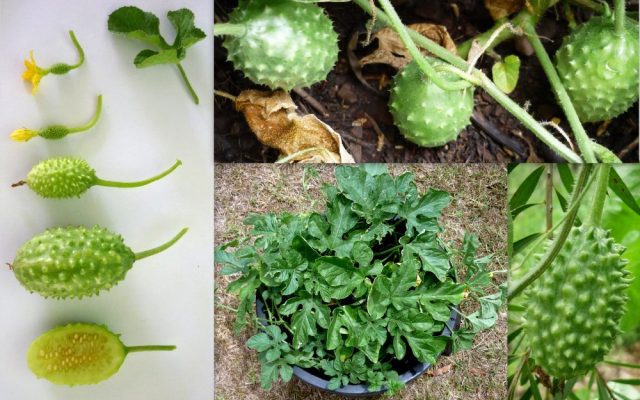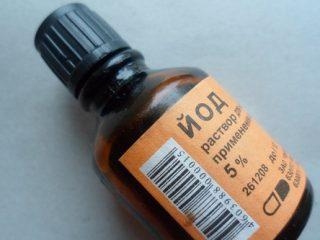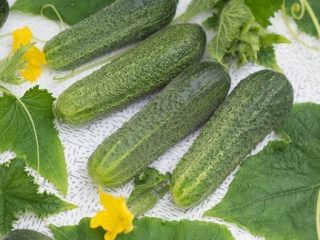Content
Anguria can be used as an ornamental or vegetable crop. It is most often grown by exotic lovers, since the Antillean cucumber successfully replaces the ordinary one on the dining table, and gardeners prefer to plant perennials to decorate pergolas and gazebos.
However, some gourmets consider the fruits of Anguria to be a delicacy; they are tasty and healthy, and the plant itself rarely gets sick or is affected by pests. The agricultural technology of the Antillean cucumber is simple, seedlings can be grown independently, and the seeds are inexpensive. Why not plant it?
What is Anguria
Anguria (Cucumis anguria) is called watermelon, horned or Antillean cucumber. Indeed, it is a species belonging to the genus Cucumber (Cucumis) of the Pumpkin family (Cucurbitaceae).
They write anything and everything about the origin of Anguria. Some sources generally “settled” the culture in Central and South America, India and the Far East. But this is not a genus, but a species. It does not happen that it arose simultaneously on different continents.One species cannot appear even in such remote parts of Asia. Some authors generally argue that Anguria is unknown in the wild, but came into cultivation thanks to the Indians.
It's actually not that confusing. Wild Cucumis anguria grows in eastern and southern Africa, Madagascar, and produces bitter fruit. When slaves were brought to America from the black continent, anguria seeds also ended up there. Through selection, fruits devoid of bitterness were obtained, the plant went wild and spread throughout the Caribbean, Latin America and the southern United States.
Over time, Anguria has become so established that in some regions it is considered a weed. They are fighting it unsuccessfully in Australia, and in North American peanut fields the crop has become a real problem.
Kiwano (Cucumis metulifer) is often, wittingly or unwittingly, confused with the Antillean Cucumber (Cucumis anguria). They especially like to insert more impressive and vibrant photographs of a second culture where they do not belong.
Photo of Anguria (Cucumis anguria)
Photo of Kiwano (Cucumis metulifer)
The difference is not that difficult to notice. Not only the fruits are different, but also the leaves.
Description and varieties of Anguria
Anguria is an annual vine that can reach a height of 5-6 m under favorable conditions and has a creeping stem covered with fine hairs. In Russia it rarely grows more than 3-4 m.
If anguria is used as an ornamental plant or planted in a greenhouse, the young shoot is directed to a support. When it grows a little, it will release numerous tendrils and will entwine arbors, trellises, pergolas, or climb any installed structure.
Unlike most representatives of the Cucumis genus, Anguria is edible and decorative at the same time. She rarely gets sick, and the carved, watermelon-like leaves remain beautiful all season long.
The yellow dioecious flowers are inconspicuous, but the fruits of the Antillean cucumber look attractive - oval, up to 8 cm long, 4 cm in cross-section, weighing from 35 to 50 g. Anguria greens are covered with rather soft thorns, which harden as the seeds ripen. The fruits become more beautiful over time - yellow or orange, the skin hardens, and they can be stored for a long time.
Only Anguria greens are suitable for food - they are eaten fresh, salted, canned, pickled. The taste of the raw fruit is a bit like cucumber, but astringent and sweetish.
If greens are not picked on time, they will become inedible. Biological ripeness usually occurs 70 days after emergence, technical ripeness - after 45-55, depending on growing conditions and variety. Anguria juice is red.
Fruiting is abundant; one vine can grow up to 200 greens in a season. If harvested, they will appear until almost frost.
When growing anguria as an ornamental annual, the fruits will ripen, become more beautiful and inedible, and acquire a strong skin and prickly thorns. At this stage, the greens will stop setting. The seeds ripen, which means the plant has fulfilled its task and laid the foundation for the emergence of a new generation of anguria.
Few varieties and varieties of Antillean cucumber are known in Russia. Anguria Dietary is even included in the State Register (2013). It reaches removable maturity in 48-50 days, has beautiful striped greens up to 6.5 cm long and weighing no more than 50 g, greenish-yellow juicy pulp.The shoots of Anguria Dietica are fragile and branch well. Up to 50 greens are harvested from one plant per season.
The Anguria variety Gourmet produces light green fruits with large thorns. It grows up to 3 m and is grown to decorate the garden and produce greens.
Anguria Syrian can bear fruit until frost. It is distinguished by abundant lateral branching and sweetish light green fruits 7-8 cm long. As an ornamental and vegetable crop, Anguria of this variety is grown on a trellis.
The benefits and harms of anguria
100 g of Antillean cucumber contains 44 kcal. Zelentsy are valued for their high content of B vitamins and potassium. Anguria contains iron, copper, zinc, manganese, and vitamin P.
Beneficial properties of the Antillean cucumber:
- the seeds are a proven anthelmintic - they are dried, ground, diluted to an emulsion with water and eaten;
- Anguria is believed to alleviate jaundice;
- raw greens help remove sand and stones from the kidneys;
- Antillean cucumber juice mixed with oil is used to treat bruises;
- fruits are used to treat hemorrhoids;
- Anguria leaves infused with vinegar are used for ringworm;
- juice removes freckles;
- a decoction of the roots relieves swelling;
- fresh greens of the Antillean cucumber promote weight loss.
It is believed that anguria is a safe product, except for individual intolerance. But when using it for treatment, it is better to consult a doctor and know when to stop, without eating kilograms of greens.
Uses of Antillean cucumber
Anguria is used in cooking. The Antillean cucumber is most popular in Brazil, which is perhaps why many consider it the birthplace of the plant. Greens are eaten raw, fried, stewed, salted, pickled.By and large, when preparing dishes they are used in the same way as a cucumber.
Ripe anguria fruits look beautiful and are stored for a long time. They are used in making crafts, decorating rooms, and even as Christmas tree decorations.
Bitter forms of the Antillean cucumber are sometimes used as a natural pesticide in granaries.
Features of growing Anguria
Antillean cucumber is a heat-loving crop. It grows better in the tropics and subtropics, although it can bear fruit and decorate the area in a temperate climate.
It prefers temperatures from 21 to 28° C. The lower critical mark is considered to be 8° C, the upper – 32° C.
Anguria requires fertile, well-retaining moisture, loose, drained soil with a neutral or slightly alkaline reaction and a maximally sunny position. Loves frequent watering with warm water, does not tolerate cold weather and acidic soils.
If the Antillean cucumber is tied to a trellis, it is better to place it on the south side of the buildings and protect it from the wind.
Planting and caring for anguria
By and large, you need to grow anguria in the same way as cucumbers. Their agricultural technology is similar, but the exotic crop in the middle zone did not have time to acquire a large number of diseases and pests.
Preparing the landing site
Good precursors for anguria will be legumes, any greens and root vegetables. The soil needs to be dug up, weeds must be removed along with the roots, and if necessary, humus, peat and sand must be added. If the soil is acidic, before loosening the surface is covered with lime or dolomite flour, depending on the pH level - from 0.5 to 1 liter per 1 square meter. m.
It is best to dig up the area in the fall, and before planting the Antillean cucumber, simply loosen it with a rake.In any case, the operation is carried out no later than 2 weeks before sowing anguria seeds or moving seedlings into open ground.
Seed preparation
In the southern regions, anguria can be sown directly into the ground. In the north, it is better to first grow seedlings in peat cups - the Antillean cucumber, like a regular one, does not like its roots being disturbed. Consequently, there can be no talk of any picking or transplanting from common boxes.
Anguria seeds are prepared in the same way as regular cucumbers - heated or soaked. Planted in a nutrient mixture to a depth of 1 cm and watered generously with warm water. Keep at a temperature close to 22° C, high humidity and good lighting. The best place for Antillean cucumbers is a southern windowsill.
Before moving into the ground, Anguria seedlings must be hardened off. Within 10 days they begin to take her outside - first for 2 hours, but every day the time spent in the fresh air increases. For the last 2 days, Antillean cucumbers have not been brought indoors even at night.
Growing anguria from seeds by sowing them directly into the ground is not difficult, it just takes longer, and in the northern regions the first harvest will be received late. And the culture will not last long as a decoration for gazebos - even with a short-term drop in temperature to 8°, the Antillean cucumber may die.
Landing rules
When the seedlings have formed 2 pairs of true leaves, and the soil temperature is 10 ° C or more, the threat of return frosts has passed, Anguria can be planted in open ground. If the weather permits, it is better to work on a warm, cloudy day.
The holes for the Antillean cucumber are made at a distance of 50 cm from each other, in one row. A handful of rotted humus and ash is poured into each and thoroughly mixed with fertile soil. You can replace organic matter with mineral fertilizers, for example, a tablespoon of nitroammophoska.
Water the holes well, when the water is absorbed, plant the Antillean cucumber seedlings. It is better to place the support right away - in the open ground, in a week, anguria can grow by 20 cm, and it needs to cling to something. The recommended trellis height is 120-150 cm.
Watering and fertilizing
Anguria needs frequent, abundant watering. The water should be warm, or the same temperature as indicated by the outdoor thermometer. Cold weather is likely to cause illness and, possibly, death of the Antillean cucumber.
The soil must be constantly moist. In hot, dry summers, anguria will have to be watered daily, at first spending 2 liters per root. A month after planting seedlings in open ground, the need for water will double.
It is impossible to grow anguria without regular fertilizing - the vine grows large, produces a lot of greens, and applying fertilizers gives it all the substances necessary for life. If the Antillean cucumber decorates the area, there should be no problems. But supporters of organic farming should think in advance about how they will feed the crop, prepare ash, mullein, or leave green fertilizer to ferment.
Anguria is fed every 2 weeks, ideally alternating organic and mineral preparations.If you dilute purchased fertilizers according to the instructions, the mullein infusion is 1:10, and the herb infusion is 1:5, it is enough to pour 0.5 liters under the root.
The Antillean cucumber has a delicate root system, so fertilizing should be diluted with water. Dry ones should not be added, even if they are well embedded in the ground.
Anguria is very fond of foliar feeding, but if the greens are used for food, they can only be done before flowering begins. To do this, you can use special fertilizers, or dilute 2 teaspoons of nitroammophoska in 10 liters of water.
Topping
Anguria grown as an ornamental crop is often not pinched at all. Here the task of the vine is to weave the support as thickly as possible to create maximum decorativeness.
It’s another matter when they want to get a good harvest of Antillean cucumbers. Then the main shoot is pinched, the 3-4 lowest side shoots are completely removed - they practically do not produce a harvest, since they are in the shade and only take away nutrients.
The remaining side shoots are shortened as soon as they grow a little. When the main shoot is thrown over a horizontally stretched wire, pinching is stopped. This is how Anguria will produce a full harvest. Perhaps it will not be as abundant as in the wild, and the owners will receive half or three times less greens. But they will be large, beautiful and tasty.
Diseases and pests
Anguria does not get sick and is affected by pests as often as ordinary cucumbers, but you should not forget that these are species belonging to the same genus. How to plant crops nearby.Then no resistance will help the Antillean cucumber - both pests and diseases will transfer to it from its “ordinary” relative.
At the first signs of damage, you need to use chemicals, strictly following the recommendations on the packaging, or folk remedies. Processing must be completed (unless a different period is specified in the instructions) no later than 20 days before the start of harvest.
Most often, anguria is affected by:
- powdery mildew;
- rot;
- anthracnose.
Possible pests include:
- aphids;
- mites;
- slugs (if the Antillean cucumber is grown without support).
Harvesting
Only Antillean cucumbers growing in natural conditions, or rather, those that have mastered and become wild in Central and South America, produce 200 fruits per vine. In Russia, southerners can collect 100 high-quality greens, northerners - half as much, because the growing season of anguria there is much shorter.
Unlike ordinary cucumbers, Antillean cucumbers are edible only when young; they begin to be collected when the skin is easily pierced with a fingernail and the size has reached 5 cm. This is done every 2-3 days, preferably early in the morning - only then will anguria be stored fresh for 7-10 days.
Conclusion
Anguria is unlikely to replace ordinary cucumbers on our table, but as an exotic culture it has a right to exist. Pickled or salted greens can decorate a holiday table, and their taste is pleasant and unusual. In addition, the Antillean cucumber can be grown simply to decorate the site.
Reviews of Anguria (Antillean cucumber)
And then my grandchildren came from Moscow for the summer and went straight to the gazebo. It turns out that they were slowly eating the greens. And we didn’t even know they were edible. We looked on the Internet, it turns out that Antillean cucumbers can be put in salads and canned. Now I grow anguria on the south side of the fence on a trellis, fortunately I have collected the seeds.
















